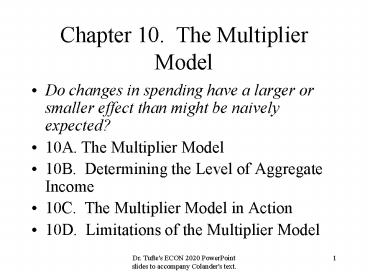Chapter 10. The Multiplier Model PowerPoint PPT Presentation
1 / 19
Title: Chapter 10. The Multiplier Model
1
Chapter 10. The Multiplier Model
- Do changes in spending have a larger or smaller
effect than might be naively expected? - 10A. The Multiplier Model
- 10B. Determining the Level of Aggregate Income
- 10C. The Multiplier Model in Action
- 10D. Limitations of the Multiplier Model
2
10A. The Multiplier Model
- What does it mean to say that this model is
quantitative, and the model in Chapter 9 wan
qualitative? - What does the multiplier model assume is fixed or
constant? - 10A.1. Aggregate Production
- 10A.2. Aggregate Expenditures
3
10A.1. Aggregate Production
- How do we graph this? In what space?
- Why is this shown as a 45 degree line?
4
10A.2. Aggregate Expenditures
- What are the two main classes of expenditures?
- How do we graph aggregate expenditures?
- Which class corresponds to the intercept and
which to the slope? - What is the special name for the slope?
5
10B. Determining the Level of Aggregate Income
- Are the two lines on the graph showing
possibilities or what really happens? - 10B.1. The Multiplier Equation
- 10B.2. The Multiplier Process
- 10B.3. The Circular Flow Model and the Intuition
behind the Multiplier Process
6
10B.1. The Multiplier Equation
- What is the formula for the multiplier?
- What happens to the multiplier as the MPC
changes? - Is MPC likely to change? Through time? Across
countries?
7
10B.2. The Multiplier Process
- How do firms recognize that production is out of
line with income? - How do they respond?
- Does that eliminate the problem completely? If
not, then what happens?
8
10B.3. The Circular Flow Model and the Intuition
behind the Multiplier Process
- What is another formula for the multiplier?
9
10C. The Multiplier Model in Action
- 10C.1. The Steps of the Multiplier Process
- 10C.2. Examples of the Effects of Shifts in
Aggregate Expenditures
10
10C.1. The Steps of the Multiplier Process
- What happens to the size of the steps as time
goes forward? - Where does that progression end? How many steps
does that take? - Does the number of steps change as the MPC
changes? If not, what does change?
11
10C.2. Examples of the Effects of Shifts in
Aggregate Expenditures
- What is the paradox of thrift?
- This is an example of what philosophical problem?
12
10D. Limitations of the Multiplier Model
- Is anything in economics ever easy? Is that
because peoples behavior is difficult to
describe? - 10D.1. The Multiplier Model Is Not a Complete
Model of the Economy - 10D.2. Shifts Are Not as Great as Intuition
Suggests - 10D.3. The Price Level Will Often Change in
Response to Shifts in Demand
13
10D. Limitations of the Multiplier Model
(continued)
- 10D.4. Peoples Forward-Looking Expectations
Make the Adjustment Process Much More Complicated - 10D.5. Shifts in Expenditures Might Reflect
Desired Shifts in Supply and Demand - 10D.6. Expenditures Depend on Much More Than
Current Income
14
10D.1. The Multiplier Model Is Not a Complete
Model of the Economy
- Whats missing from the multiplier model?
15
10D.2. Shifts Are Not as Great as Intuition
Suggests
- Are autonomous expenditures a broad idea, where
we could place just about any change in spending?
16
10D.3. The Price Level Will Often Change in
Response to Shifts in Demand
- What did we assume was fixed in this model?
- If it isnt fixed, how will the multiplier
process change?
17
10D.4. Peoples Forward-Looking Expectations
Make the Adjustment Process Much More Complicated
- Does the multiplier model assume that everyone in
the chain of expenditures will spend the money? - Why wouldnt they? What if they dont?
18
10D.5. Shifts in Expenditures Might Reflect
Desired Shifts in Supply and Demand
- Is the definition of autonomous expenditures
consistent with reality? - Could expenditures change in ways that appear
autonomous (on the surface), but are really not
autonomous?
19
10D.6. Expenditures Depend on Much More Than
Current Income
- Does your spending depend on your current income
only? - What other form of income does your spending
depend on? - Is that form smoother or more volatile than your
current income? - Would you always respond in the way described if
you didnt exclusively focus on current income?

